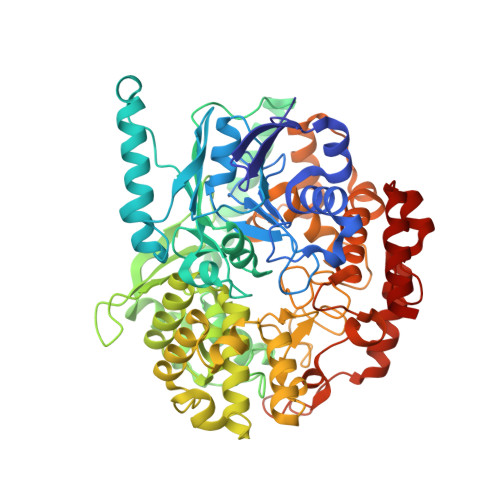An unprecedented function for a tungsten-containing oxidoreductase.
Mathew, L.G., Haja, D.K., Pritchett, C., McCormick, W., Zeineddine, R., Fontenot, L.S., Rivera, M.E., Glushka, J., Adams, M.W.W., Lanzilotta, W.N.(2022) J Biol Inorg Chem 27: 747-758
- PubMed: 36269456
- DOI: https://doi.org/10.1007/s00775-022-01965-0
- Primary Citation of Related Structures:
6X1O, 6X6U - PubMed Abstract:
Five tungstopterin-containing oxidoreductases were characterized from the hyperthermophile Pyrococcus furiosus. Each enzyme catalyzes the reversible conversion of one or more aldehydes to the corresponding carboxylic acid, but they have different specificities. The physiological functions of only two of these enzymes are known: one, termed GAPOR, is a glycolytic enzyme that oxidizes glyceraldehyde-3-phosphate, while the other, termed AOR, oxidizes multiple aldehydes generated during peptide fermentation. Two of the enzymes have known structures (AOR and FOR). Herein, we focus on WOR5, the fifth tungstopterin enzyme to be discovered in P. furiosus. Expression of WOR5 was previously shown to be increased during cold shock (growth at 72 ℃), although the physiological substrate is not known. To gain insight into WOR5 function, we sought to determine both its structure and identify its intracellular substrate. Crystallization experiments were performed with a concentrated cytoplasmic extract of P. furiosus grown at 72 ℃ and the structure of WOR5 was deduced from the crystals that were obtained. In contrast to a previous report, WOR5 is heterodimeric containing an additional polyferredoxin-like subunit with four [4Fe-4S] clusters. The active site structure of WOR5 is substantially different from that of AOR and FOR and the significant electron density observed adjacent to the tungsten cofactor of WOR5 was modeled as an aliphatic sulfonate. Biochemical assays and product analysis confirmed that WOR5 is an aliphatic sulfonate ferredoxin oxidoreductase (ASOR). A catalytic mechanism for ASOR is proposed based on the structural information and the potential role of ASOR in the cold-shock response is discussed.
Organizational Affiliation:
Department of Biochemistry and Molecular Biology, University of Georgia, Athens, GA, 30602, USA.

























